To commemorate William Wyler's monumental epic
"BEN-HUR" shot in MGM's Camera 65 |
Read more at in70mm.com The 70mm Newsletter |
| Written by: Gerhard Witte, Berlin, Germany. A presentation by the editor. See Gerhard's original report as a PDF. | Date: 28.06.2015 |
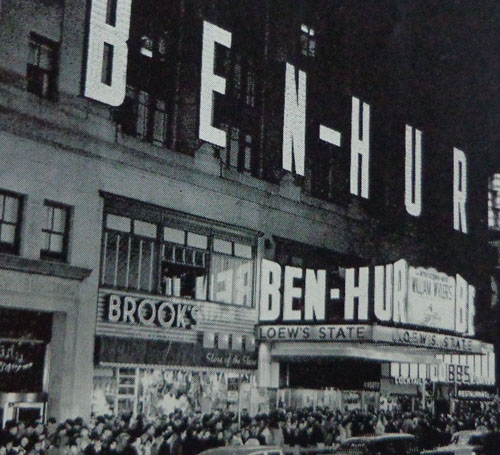 The Loew's State Theatre on Broadway at the world premiere of MGM's
magnificent film on 18 November 1959. In the year before, the movie theatre
had been closed for refurbishing and reopened on 28 March 1959 with the
World Premiere of Billy Wilder's "Some Like It Hot" (USA, 1959). At the
"Ben-Hur" premiere pedestrian traffic was at a stand-still as hundreds of
people milled around the theatre for a glance at the who's who among the
ticket holders. The movie was a great success and ran for 74 weeks. (Image
from "Motion Picture HERALD" dated 28 November 1959) The Loew's State Theatre on Broadway at the world premiere of MGM's
magnificent film on 18 November 1959. In the year before, the movie theatre
had been closed for refurbishing and reopened on 28 March 1959 with the
World Premiere of Billy Wilder's "Some Like It Hot" (USA, 1959). At the
"Ben-Hur" premiere pedestrian traffic was at a stand-still as hundreds of
people milled around the theatre for a glance at the who's who among the
ticket holders. The movie was a great success and ran for 74 weeks. (Image
from "Motion Picture HERALD" dated 28 November 1959)"We at MGM feel pride, a justifiable one we believe, in placing this great 'Tale of the Christ´ before the public", said Joseph R. Vogel, President of MGM. Following proud announcements by Metro-Goldwyn-Mayer, the roadshow premiere of William Wyler's film "Ben-Hur" took place at the Loew's State Theatre on Broadway in New York on 18 November 1959. There have already been numerous reports about this brilliant and highly successful film. In addition, the DVD / Blu-Ray editions of the film now available commercially offer extensive new and interesting additional material. There is also very detailed information about the film available on Wikipedia. In this report, I would like to convey some details about the film that are less well-known or have maybe already been forgotten. The newspapers, most notably the "New York VARIETY", disseminated various information at the time of the movie's world premiere, including the following: The culmination of five years preparation, 10 months of shooting and two years of concentrated ballyhoo will take place tonight when the around $15.000.000 (estimated by MGM) film "Ben-Hur" is officially unveiled at the Loew's State Theatre on Broadway. There was not a chariot to be seen in the area of the Loew's State Theatre in New York, as "Ben-Hur" had its formal premiere on Wednesday night (18.11.1959). No blaring of horns, no circus trappings, no glamor girls being interviewed in the lobby. At the behest of Joseph R. Vogel, president of MGM's parent company Loew's, Inc., "Ben-Hur" bowed with dignity. It was a high-hat and highbrow nature first-night audience. It was MGM's big night, rivaling in importance the major unveilings back through the years: Griffith's "The Birth of a Nation" (USA, 1915), Crosland's "The Jazz Singer" (USA, 1927), the Opening of the Radio City Music Hall (1932), Fleming's "Gone with the Wind" (USA, 1939) and Cinerama (1952). Compliments: A.) An Editorial in the "New York World Telegram & Sun" provided MGM with an unusual accolade for its "Ben-Hur" at the time: Thirty-four years have passed since Ramón Novarro and Francis X. Bushmann thrilled silent screen patrons with "Ben-Hur" (USA, 1925). Eighty years (1880) have passed since Lew Wallace's famous novel was first published. But MGM's magnificent new production of "Ben-Hur" at the Loew's State Theatre proves that this drama of early Christianity is timeless. Director William Wyler expressed it well: "This is still a contemporary story: The Biblical tale of an age without pity, without compassion that has many parallels today." B.) Rare is tribute coming from a competitor, particularly in the picture business. But it's happening. RKO Theatres placed on 16 November 1959 at its own expense a four-inch two-column advert in the New York Times with the text: "We congratulate MGM on its superb production "Ben-Hur". It is a credit to the entire Motion Picture Industry and one of the great entertainment experiences of all time. We urge everyone to see it." (Sol Schwartz, President of RKO Pictures and Harry Mandel, Vice-President in Charge of Theatre Operations) |
More in 70mm reading: “Ben-Hur” 50th Anniversary Gallery: "BEN-HUR" shot in MGM's Camera 65 PDF: To commemorate William Wyler's monumental epic "BEN-HUR" shot in MGM's Camera 65 PDF: Zur Erinnerung an William Wylers monumentales Epos "BEN-HUR", gefilmt in MGMs Camera 65 Gerhard Witte's in70mm.com Library Internet link: The Loew's State Theatre Ben Hur's premiere in New York Egyptian Theatre The Empire Gaumont-Palace, Paris: salles-cinema.com paris-louxor.fr fr.wikipedia.org Musée Gaumont American Widescreen Museum "Ben-Hur" Trailer in HD Ben Hur's Tokyo premiere Benjamin A. Stahl Reynold Brown William Wyler accepts the AFI Life Achievement Award in 1976 11 Oscars for Ben-Hur Charlton Heston's last Interview blu-ray.com |
The Production
|
|
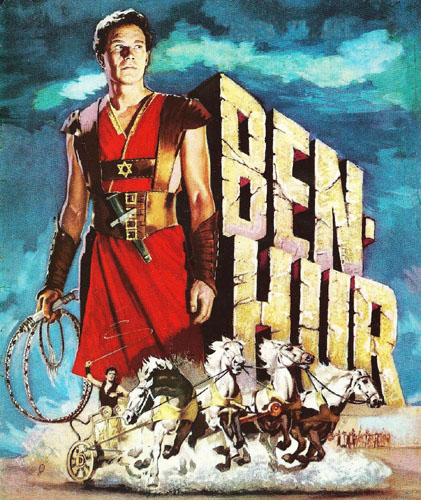 Drawing from the author's collection. Drawing from the author's collection.MGM was in troubled financial waters when they undertook "Ben-Hur". In the successful wide-screen, religious-epic epoch of the 1950s it was MGM's made go-for-broke move - a film which would either sink or save the studio. As Hollywood production cost began to inflate markedly, MGM realized that they could save a lot of money by shooting the entire film in Italy. "Ben-Hur" is a work of superlatives. It needed around five years of preparation - the most expensive Hollywood film ever made at the time. "Ben-Hur" was shot in the Cinecittà studios (on the outskirts of Rome) and in the Italian mountain village Arcinazzo Romano, located east of Rome - by car about 50 miles / 80 km - that turned into the town of Nazareth. Further film locations were, for example, the sandy beaches near Anzio (desert oasis sequences) and even Arizona (USA) for additional short desert panoramas (from Wikipedia)*. Caves just south of Rome served as the leper colony. Initially, it had also been planned to film some scenes in Libya (North Africa), however the Libyan government canceled the production's film permit for religious reasons. The very first sequences that were shot for the film were the 'sea battle scenes´. That had been in November and December 1957. They used ship-miniatures in a tank on the back lot at the MGM Studios in Culver City (California). * For information: In Europe there is only one real large desert landscape that can be used as a filming location for movies - especially for Western movies. It is the desert of Tabernas (Desierto de Tabernas) located in Andalusia (Spain) in the province of Almeria. The integral nature reserve is 11625 hectares (116.25 km²) in size and is a bizarre world of stone and loam - no large sand dunes. Once, there were also shot some scenes for David Lean's "Lawrence of Arabia" (UK, 1962) or for the movie "Once Upon a Time in the West" (Italy / USA, 1968). Charlton Heston wrote in his diary that shooting for the movie in Italy started on 20 May 1958 and ended (principal photography) on 07 January 1959. Pre and post-production took up an additional 6 to 7 months or so each. The statistics concerning the production were overwhelming. They included for example: six $100.000 Camera 65 units, more than 15.000 sketches and drawings of costumes, sets and props. Over 300 sets were built in the Cinecittà studios. Scattered over an area of 148 acres (0,6 km²), the art directors William A. Horning and Edward C. Carfagno created the glory and grandeur of Rome and Jerusalem. There were props numbered over a million: around 100.000 costumes, 3.400 pairs of shoes, 3.000 swords, 2.600 shields, tons of specially designed ceramic tile, etc., etc. In addition: 78 specially trained horses for the Chariot Race, 12 camels from North Africa, hundreds of other horses, sheep and other animals. During the production around 25.500 tourists visited the sets in Rome and additionally about 500 accredited members of the press, including 15 from the Soviet Union. Around 1.250.000 feet (381 kilometres) of exposed film in the Camera 65 process had been edited down to around 19.000 feet (5790 metres) for the film's final version. Each full print of the film weighs 480 lbs (218 kilograms). (Source: "New York VARIETY"). Author's comment: 19.000 feet (5790 metres) is most likely the length of the movie's 35mm version. I think that the 70mm version is around 23.850 feet (7270 metres) long – calculated at a movie running time of 212 minutes. The projection speed of a traditional 70mm film is 112.5 feet (34,3 metres) per minute compared to 90 feet (27,4 metres) per minute for a 35mm film. |
|
Worldwide Release (source: "New York VARIETY") |
|
|
Morton A. Spring, President of Metro-Goldwyn-Mayer International, announced
end of 1959 that the Latin American premiere of
“Ben-Hur” would be held on
30.03.1960 in San Juan, Lima on April 06, Caracas would open on April 13,
Santiago on May 04.
Further worldwide locations would be: Singapore on 05 May 1960, Montevideo
on May 11 and Sydney on May 15. Melbourne would have its premiere on June
01, Bombay on June 15 and Calcutta on June 22.
Metro Goldwyn Mayer's Vice-President of South-America and of the Near and
Far East, Seymour Mayer, revealed in November 1959 that "Ben-Hur" would open
in Tokyo (東京) on 01 April 1960, in mid-April in Osaka (大阪市) and late April
or early May in Nagoya (名古屋市).
Seymour Mayer expected the picture to run for two years in Tokyo. Pattern of
exhibition should be all-seat-reserved with two showings daily and three on
weekends and holidays. |
|
No Screening of the Movie in the United Arab Republic (UAR) |
|
|
In May 1960 in the "New York VARIETY" wrote: "Ben-Hur" banned in the UAR (United Arab Republic). (The UAR was a political union between the Arab states of Egypt and Syria in the period from 1958 to 1961, Author) William Wyler announced that screening "Ben-Hur" was prohibited in all countries of the UAR because the female lead Haya Harareet came from Israel. He thought this stance was rather small-minded and pointed out that the movie stood for friendship between people from all ethnic backgrounds and that Arabs and Jews in the movie were friends and supported one another. The movie was received in other Muslim countries as well as by Christians and Jews in the USA and the UK. Hugh Griffith plays a highly personable Arab in the movie and even received an Oscar for the role. The movie is a great hit even in Japan, where Shintoism and Buddhism are the main religions. |
|
Metro-Goldwyn-Mayer's Camera 65
|
|
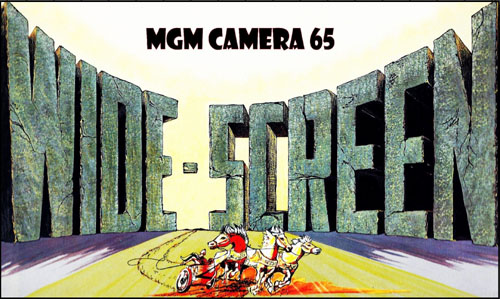 Drawing from a Record-Cover. (LP Album Somerset P-16400 / The Majesty of
Scores composed by Miklos Rozsa) Drawing from a Record-Cover. (LP Album Somerset P-16400 / The Majesty of
Scores composed by Miklos Rozsa)Sir Sydney Samuelson, the first British Film Commissioner, reported about his deceased friend and colleague Robert E, Gottschalk (12.03.1918 - 03.06.1982), the famous American camera technician and founder of Panavision, Inc., that he was totally convinced that the true image quality of a movie depended on the size of the original camera negative - the larger the better. For a long time, people wanted to stick with the 35mm film format at any cost - just think of Cinerama (3 x 35mm, 1952) or CinemaScope (1 x 35mm, 1953). But even with those, it was immediately obvious that reproduction on particularly wide large screens made a considerably stronger impression. The 35mm image has a useful area of approx. 320mm² - a 70mm image an area of nearly 1100mm². Given the same image quality, the 70mm film can therefore be projected onto a screen that is approximately 3½ times larger. That is the idea and purpose of 70mm technology - to create a projection with a brilliant and sharp image, which almost fills the viewer's field of vision, i.e. draws viewers into the screen action from virtually any seat. Of course the relationship to the screen size, possibly curved, and to the length of the auditorium is also crucial. Venues that can erect a screen that is at least half as wide as the auditorium is long, or even better three fifths as wide, are particularly well suited to screening 70mm movies. In October 1955, Michael Todd's 70mm Todd-AO movie "Oklahoma" (USA, 1955), recorded at 30 frames per second with a spherical lens and a max aspect ratio of 2.21:1, went on general release. This aspect ratio provided dimensions that made for rather good viewing from all seats, whether closer to or further away from the screen. As early as in the spring of 1955, MGM announced that in future "big budget movies" should be shot on 65mm negative film. Panavision, Inc. (Robert E. Gottschalk) was commissioned to manufacture new anamorphic camera lenses, which would satisfy different requirements based on a MGM wish list. For MGM, this subsequently resulted 1956 in a similar setup as that used in the Todd-AO process of Michael Todd. MGM also used 65mm negative film, but with the difference that they recorded with 24 images per second as well as anamorphically. The cameras they initially used were old 70mm Mitchell Fox Cameras which had been developed end of the 1920s - already at that time they worked with wide film. For the new project Mitchell Camera Corporation converted these cameras from 70mm to 65mm negative film. Once, these cameras had been used for the shooting of King Vidor's "Billy the Kid" (USA, 1930) in MGM's newly developed 70mm-Realife-Process. Parallel to this, an additional "alternate regular version" of the film was shot in 35mm. The 70mm version was only shown with 35mm reduction prints in an aspect ratio of 1.75:1 in cinemas. Realife was never presented in 70mm. The sound came from discs. Filming was now carried out using an anamorphic prism lens called "APO Panatar" newly developed by Panavision, Inc. (a high quality prime lens fitted into a housing that also contains a pair of prism). This lens stretches the camera image vertically recorded on the 65mm negative film by a moderate factor of 1.25. |
|
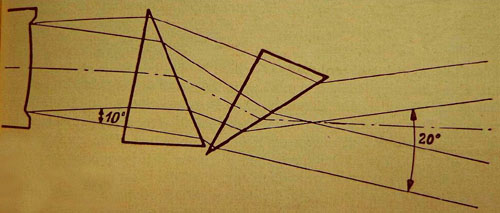 Schematic diagram: Left the lens and in front of it two prisms that distort
the image. Schematic diagram: Left the lens and in front of it two prisms that distort
the image.The special feature of these so-called "Gottschalk" systems is an image distortion caused by a prism refracting a beam. This anamorphic stretching effect can be further enhanced by using two prisms. MGM gave the new film process the name "Camera 65" (marketing brand). The first film that was produced in this process got the additional designation "Window of the World". It is the movie "Raintree County" (USA, 1957). However, only 35mm "reduction prints" (CinemaScope) were unfortunately produced upon completion and it is those that went on general release. "Ben-Hur" was the next project. On completion, it was distributed with 70mm prints and 6-channel magnetic sound. With the appropriate anamorphic projection lens, the new Camera 65 process delivered a particularly wide and impressive maximum aspect ratio of 2.21:1 x 1.25 = 2.76:1 on cinema screens. Start of the 1960s, MGM sold its camera inventory to Panavision, Inc. The product description (marketing brand) "MGM Camera 65" was abandoned. Panavision, Inc. called it - now with newly developed lenses and more comfortable and lighter cameras - "Ultra Panavision 70". The aspect ratio of 2.76:1 was maintained. For MGM's next big 70mm movie, Lewis Milestone's "Mutiny on the Bounty" (USA, 1962), MGM leased the improved cameras and lenses from Panavision, Inc. back and the movie was released with the description "…filmed in Ultra Panavision 70". MGM's "Camera 65" and Panavision's "Ultra Panavision 70" therefore ultimately referred to the same recording process. In 1959, Robert E. Gottschalk received a "Scientific or Technical Award" (Class II = a Plaque) for: "…the development of a system of producing and exhibiting wide-film motion pictures known as Camera 65", which he shared with Douglas Shearer (MGM Chief of Research and Development) and John R. Moore (co-founder (1953/54) of Panavision, Inc.). |
|
No early 35mm-Release of "Ben-Hur"
|
|
|
MGM's policy was largely based on the hits and errors also tallied by two
previous roadshow movies at the time: "Around the World in 80 Days" (USA,
1956) and "The Ten Commandments" (USA, 1956). The company's sales executives
had carefully studied the release pattern of these two movies and the
experience of these films in various dates as it moved down the line.
MGM withheld all 35mm dates until it was sure that the 70mm hard ticket date
had been washed up. Then, and only then, "Ben-Hur" would be trickled down to
the lesser situations in 35mm. It should be earliest in June 1960, better
later, before any theatre in the U.S. or abroad could hope to obtain a 35mm
booking.
The $15.000.000 cost of "Ben-Hur" had MGM taking extreme care that the movie
did not receive too speedy a playoff. MGM was convinced that a too-early
issuance of the 35mm version would destroy the film's potential and that not
even the cost of the print could be recovered under those circumstances. In June 1960 it was reported: The first 35mm presentation will take place on 16 June 1960 at the Albert Aaron's 600-seat Capitol Theatre in Charlestown (West-Virginia). Subsequently during June, the movie will be shown in 35mm in Dayton (Ohio), in Providence (Rhode Island), in Grand Rapids (Michigan), in Wichita (Kansas) and in El Paso (Texas). |
|
The Awards |
|
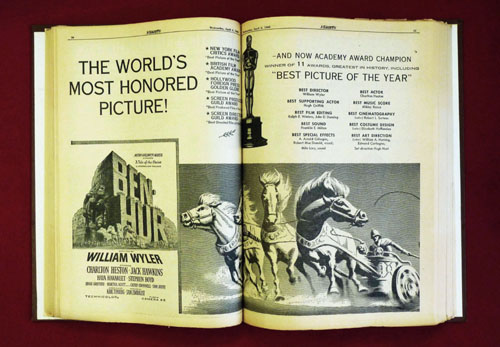 The Academy Awards honored film achievements of 1959 were given on 04 April
1960 at the RKO Pantages Theatre in Los Angeles.
GREAT! 11 Oscars for the epic film. (A wonderful two-sided advert in the
"New York VARIETY" dated 06 April 1960) The Academy Awards honored film achievements of 1959 were given on 04 April
1960 at the RKO Pantages Theatre in Los Angeles.
GREAT! 11 Oscars for the epic film. (A wonderful two-sided advert in the
"New York VARIETY" dated 06 April 1960) "Ben-Hur" (USA, 1959) was the first film to earn unbelievable 11 academy awards in 1960 - the greatest number of awards ever received by a picture in the history of the Academy of Motion Picture Arts and Sciences. This had been unmatched for almost four decades. In the years 1998 and 2004 the movies "Titanic" (USA, 1997) and "The Lord of the Rings: The Return of the King" (USA, 2003) followed and were also honored with 11 Oscars respectively. Apart from that, "Ben-Hur" was voted best movie of the year in 1959, being awarded, amongst others, the Golden Globe (Drama) and the European "Oscar", the British BAFTA, an award from the British Academy of Film and Television Arts, still called British Film Academy Award at that time. "Ben-Hur" went on to a successful world premiere tour at the time that was quite exceptional in the movie history of that era. Within just six weeks from the gala premiere in New York, "Ben-Hur" made one million dollars in twelve cinemas in the USA. By mid-February 1960, revenues from six key cities in the USA and Canada topped three million dollars. By 31.12.1960, with a gross box office of 33 million dollars, the movie had already reached place three of the absolute world bestseller list, behind "The Ten Commandments" (USA, 1956) at 34.2 and "Gone with the Wind" (USA, 1939) at 33.5 million dollars in takings. (Source: "Berliner Filmblätter") At that time, when "Ben-Hur" had been in the cinemas for nine months in the United States and the UK, the MGM planners figured on a simple method to calculate likely box office takings: one million dollars a fortnight for the foreseeable future. |
|
In the Arena |
|
 Judah Ben-Hur and his four white horses: Altair, Antares, Aldebaran and
Rigel. The entire race was shot full-scale with live action. No miniature
replica or process shots were used Judah Ben-Hur and his four white horses: Altair, Antares, Aldebaran and
Rigel. The entire race was shot full-scale with live action. No miniature
replica or process shots were used If you have a look at the image in a higher resolution you will see that it isn't Charlton Heston who is driving the chariot with the white horses. It is Joe Canutt, the son of the second-unit director of the race - Yakima Canutt. Joe doubled Heston in risky scenes and during filming he wore a face mask. This mask had been specially made from Charlton Heston's head (see images). "Joe Canutt is one of the best athletes I've ever seen - quick and strong as a leopard", said Heston. "Chuck" Heston was already a skilled rider from experience in Western movies. He arrived in Rome on 13 April 1958 and already two days later he began working with horses. After having trained some weeks he could manage a chariot as well as any expert. "Chariot teams only have three speeds: walk, trot and 'dead run´", said Heston. At the time the second-unit directors Andrew Marton and Yakima Canutt needed almost three months to film the chariot race at a total cost of around 1 Million Dollar. More than 36.000 tons (U.S. 40.000 short tons) of sand were brought in from the beaches on the Mediterranean to cover the track in the 'Stadium of Antioch', build on the back lot of Cinecittà. The arena set was the largest single set ever built for a motion picture at the time. It covered around 18 acres (72.843 m²). During the filming one of the 100.000 Dollar expensive Cameras 65, run down by a team of horses, was destroyed. By the way, a pure Hollywood invention are the vicious rotating beak-like steel cutting blades on the hubs of the wheels of Messala's "Greek" chariot. Search parties combed Europe and the Middle East to find the most hot-blooded and fastest horses for the chariot race. Already 6 months before the film's first shooting day, Glenn H. Randall Sr., Hollywood's famous animal trainer, trained 78 horses purchased for the picture's spectacular chariot race. Especially four Arabian "aristocratic" stallions - the most beautiful and docile - had to be taught to kiss and nudge their master (Sheik Ilderim) affectionately. 70 (75)* horses, mostly of Arab breed, also including a number of pure Lipizzaner horses, had come from the famous stud farm "Lipica" in Slovenia. Another 8 (3)* had been imported from Sicily. After the film was completed, the highly trained animals were sold to circuses, stables and just plain horse lovers. (* from an another source) A report on the film's German premiere (Munich) in the "Süddeutsche Zeitung" (newspaper) included the following: "The nine minutes of the chariot race deserve our admiration. They are not only among the best that the camera has ever shown where chariot racing is concerned but also among the best that the camera has ever shown at all." (Roos) |
|
Festive European Premiere of the Epic in Great Britain (London)
|
|
 Thanks to an unprecedented massive advertising campaign, "Ben-Hur" had been
on everybody's lips in the city of 12 million for weeks beforehand.
Previously, the Empire-Theatre had been undergone intensive refurbishing for
the great "Ben-Hur" premiere. The capacity of the theatre had been cut by
more than 1.000 seats to just over 1.700.
A new advance sale record had been set up for "Ben-Hur". Morton A. Spring
(President of Metro-Goldwyn-Mayer International) said in New York that the
premiere in London was breaking box office records, with the theatre's
advance sale reportedly 10 times higher than of any picture in London's
history. Although the box office opened on November 8, around 15.000 seats
had already been booked - up to the movie's premiere, the number rose to
about 30.000. Thanks to an unprecedented massive advertising campaign, "Ben-Hur" had been
on everybody's lips in the city of 12 million for weeks beforehand.
Previously, the Empire-Theatre had been undergone intensive refurbishing for
the great "Ben-Hur" premiere. The capacity of the theatre had been cut by
more than 1.000 seats to just over 1.700.
A new advance sale record had been set up for "Ben-Hur". Morton A. Spring
(President of Metro-Goldwyn-Mayer International) said in New York that the
premiere in London was breaking box office records, with the theatre's
advance sale reportedly 10 times higher than of any picture in London's
history. Although the box office opened on November 8, around 15.000 seats
had already been booked - up to the movie's premiere, the number rose to
about 30.000.Over 1000 more or less well-known guests attended the Gala Premiere. Besides the director William Wyler and the leading actors Charlton Heston, Haya Harareet, Jack Hawkins and Hugh Griffith, there was also writer Christopher Fry, a respected British poet and playwright, whose work on "Ben-Hur" was his first movie collaboration. He had supported the filming in Rome from beginning to end and it had been his contribution that really had given Karl Tunberg's screenplay its polish - "… the dialogues sometimes sing with good rhetoric and quiet poetry". Additional writers who had worked on the screenplay were: Gore Vidal, Maxwell Anderson and Samuel Nathaniel Behrman. After the reception taking place under spotlights in the cinema auditorium, many more famous personalities filled the rows of seats in the Empire Theatre, including: Sir Carol Reed, Graham Greene, Leslie Caron, Stanley Baker, David Farrar, Léo Genn, Kenneth More, Robert Morley, Heather Sears, Richard Todd, Anna Neagle, Prince George of Denmark and Members of Government, Dukes, Lords and Messengers from different Nations. (Source: "Österreichische Film- und Kinozeitung" and "La Cinématographie Francaise") "New York VARIETY" wrote at the time: "After Ben-Hur concludes its West End engagement, The Empire site will be redeveloped by Mecca Cafés, which plans to build a large ballroom. The project includes a smaller theatre which will be leased back by MGM." |
|
Festive Premiere in Japan - Japan's Emperor goes to the movies
|
|
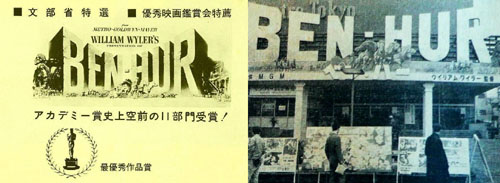 The Tokyo Theatre showing "Ben-Hur"(ベン・ハー), at the time the biggest Premiere
Movie Theatre in Japan's capital. (Image from the author's collection) The Tokyo Theatre showing "Ben-Hur"(ベン・ハー), at the time the biggest Premiere
Movie Theatre in Japan's capital. (Image from the author's collection)A memorable film night in Tokyo. Emperor Hirohito (裕仁) (29.04.1901 - 07.01.1989) and Empress Nagako (香淳皇后) (06.03.1903 - 16.06.2000) attended the "Ben-Hur" premiere. For the first time in history, a Japanese imperial couple left the "Tokyo Imperial Palace" to attend a movie premiere. Their entourage at the premiere of MGM's movie "Ben-Hur" at the Tokyo Theatre included the youngest of the Emperor's five daughters, former Princess Suga, now Takako Shimazu (島津貴子) by her married name, accompanied by her husband Hisanaga Shimazu. The premiere was also attended by Prince (高松宮宣仁親王) and Princess Takamatsu, Prince Yoshi (Masahito Hitachi (常陸宮正仁親王)) and the entire diplomatic corps. The proceeds from the event were donated to Japan's largest charity. Prince Takamatsu (03.01.1905 - 03.02.1987) was the younger brother of Emperor Hirohito. Masahito Hitachi (Prince Yoshi), born on 28.11.1935, is the sixth of the seven children of the imperial couple. Charlton Heston and his wife had travelled to Japan to welcome the Emperor and the Empress and to introduce the movie at the Tokyo Theatre. (Source: "Österreichische Film- und Kinozeitung"). Ahead of the festive premiere of the movie, the theatre had been completely redecorated and new projectors for the 70mm film had been installed in the projection booth. In his autobiography "In the Arena" (1995), Charlton Heston recounts a very unpleasant incident when the screening had to be briefly interrupted several times during the first 10 minutes as the film tore repeatedly. In awe of Emperor Hirohito's physical presence, the projectionist had unfortunately put too much tension on the film when setting up the equipment. During the entire time, the Emperor remained totally calm and sympathetic, and the screening subsequently proceeded without further incident. The next day, leading figures from the local projectionist association, from the company which owned the theatre and high-ranking Japanese MGM functionaries visited the Emperor at the palace and apologised. |
|
"Ben-Hur" at the Film Festival in Cannes 4th May 1960
|
|
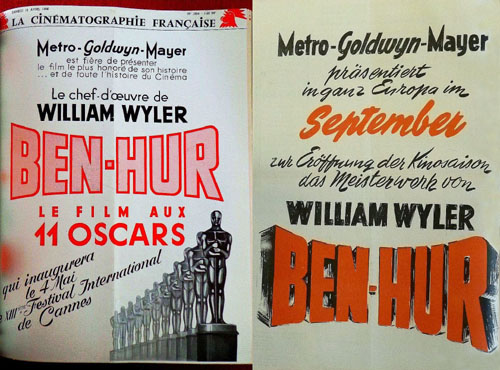 "Ben-Hur" was shown at the 13th International Film Festival in Cannes
(04.05.1960 - 20.05.1960) - title page"La Cinématographie Francaise" dated
16 April 1960. Image on the right: Metro-Goldwyn-Mayer announces the film's
premiere throughout Europe in September 1960. (Advert dated January 1960) "Ben-Hur" was shown at the 13th International Film Festival in Cannes
(04.05.1960 - 20.05.1960) - title page"La Cinématographie Francaise" dated
16 April 1960. Image on the right: Metro-Goldwyn-Mayer announces the film's
premiere throughout Europe in September 1960. (Advert dated January 1960)Metro-Goldwyn-Mayer's great spectacle opened the 13th International Film Festival in Cannes, France, on 04 May 1960. The screening of the movie, which was not entered for any of the awards, was thus simultaneously a preview on the European mainland, because the general release of the movie in that region was not planned until the autumn. The opening evening on the famous Croisette in Cannes was dominated by the impact made by the crowd-pulling sumptuous "Ben-Hur" premiere, which MGM crowned with a huge reception. The people taking centre stage were director William Wyler and charming Haya Harareet. Especially for this event, MGM set up a particularly large Hollywood subsidiary in Cannes. Leading fashion houses from Parisian haute couture showed the festival guests styles inspired by "Ben-Hur" - even Ben-Hur cigarettes were on offer. The official USA competition entry for the film festival was the MGM movie "Home from the Hill" (USA, 1960) directed by Vincente Minnelli. The festival's "Palme d'Or" that year was won by the controversial and much discussed Italian movie "La Dolce Vita" (Italy / France 1960) directed by Federico Fellini. |
|
Great Premiere in France, 6 October 1960 at the Gaumont-Palace in Paris |
|
 On the left: The Gaumont-Palace in Paris, once Europe's biggest cinema
(image from the author's collection) and on the right: A newspaper advertise
at Christmas time 1960. The Gala Premiere of "Ben-Hur" took place on
06.10.1960 with Charlton Heston's presence. On the left: The Gaumont-Palace in Paris, once Europe's biggest cinema
(image from the author's collection) and on the right: A newspaper advertise
at Christmas time 1960. The Gala Premiere of "Ben-Hur" took place on
06.10.1960 with Charlton Heston's presence. The advert included the following information: For Christmas - the best present: 2 tickets for "Ben-Hur". William Wyler's masterpiece is currently taking Paris by storm. 2 tickets for the Metro-Goldwyn-Mayer movie as a Christmas present. The tickets are now on sale at the Gaumont-Palace, 1 Rue Caulaincourt, from 12.00 noon to 07.00 pm and at the branches of travel agency "Une Semaine de Paris". You will also receive a luxurious Christmas card for posting the tickets to friends and family. Film screenings at 02.45 pm and at 08.00 pm. Admission charges: 6 NF, 8NF, 10NF und 12NF (only here is a seat reservation possible). NF = Nouveaux Francs Shortly before the film's premiere "La Cinématographie Francaise" wrote: An innovative method for pre-booking tickets for "Ben-Hur": It is said that William Wyler’s masterpiece "Ben-Hur" is going to open the new movie season with a bang on 07 October 1960 at the Gaumont-Palace in Paris. The movie and its start date have been advertised by a magnificent display at the cinema since 15 September, showing the date in illuminated letters (see image gallery). Tickets have also been on official sale there since 15 September. During the previous weeks, visitors to the 17 cinemas of the Parisian Gaumont Group had been able to make advance bookings for tickets. For this purpose, an advertising leaflet about the movie was distributed, which included a detachable coupon that people could fill in and drop into a "coupon box" (see image gallery) in the foyer of the respective cinema. That way, it was possible to process thousands of requests ahead of the movie's official ticket pre-sales. According to information from the "Berliner Filmblätter", the movie took NF (Nouveaux Francs) 3.27 million (= 650.000 dollars) with 372.264 visitors during the first 15 weeks of 2 screenings a day at the premiere cinema Gaumont-Palace. |
|
The Gaumont-Palace
|
|
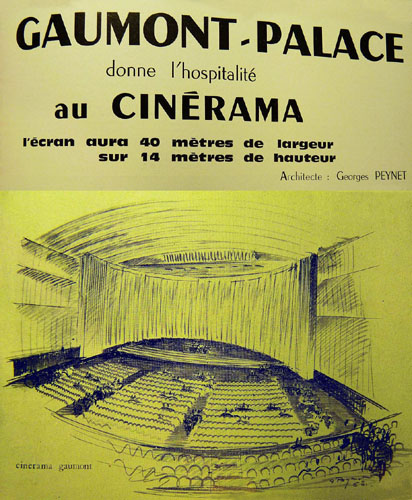 Cinerama-Gaumont-Palace. (Drawing from "La Cinématographie Francaise" /
Spécial Cannes 1963) Cinerama-Gaumont-Palace. (Drawing from "La Cinématographie Francaise" /
Spécial Cannes 1963)Once, the Gaumont-Palace in Paris was the biggest movie theatre in Europe "La plus grande salle d'Europe" with around 6000 seats. After the Second World War they were reduced to around 4600. In 1959, the 70mm-era emerged in the Gaumont with the installation of two Philips DP70 projectors in the projection room and it also got a new screen with a size of 24 x 13 metres (78,8 x 42,7 feet). The number of seats was reduced by further 400 seats to around 4200 (I have this from hearsay). In 1962, the cinema was converted into a Cinerama theatre with a colossal, deeply curved louvered screen with a size of 40 x 14 metres (131,2 x 45,9 feet) - another source states a screen size of 38,6 x 15 metres (126,6 x 49,2 feet). Three new projection booths were built in the rear side of the first balcony in order to have the best possible Cinerama projection onto the screen (a nearly level projection). Furthermore, the theatre got a huge silk curtain - one speaks of a 'golden' - with a size of 60 x 15 metres (196,8 x 49,2 feet). Cinerama movies were shown with Century JJ-1 projectors at the time. The number of seats now? Unfortunately no information. In 1963, Cinerama, Inc. insisted on the closure of the theatre's second balcony - " pour le confort des spectateurs." That reduced the theatre's seating capacity to a total of 2400 seats at the time - 550 seats in the first balcony and 1850 seats in the ground floor levels. In 1967, the contract with Cinerama, Inc. ended and all had to be rebuilt to the pre-Cinerama-era. The Palace was demolished in 1973. (Sources: Wikipedia France and "La Cinématographie Francaise"). The French "Gaumont" cinema group was founded in 1895 - the same year as the "American Mutoscope Company" (renamed "Biograph Company" in 1909) - by the French movie pioneer Léon Gaumont under the name "Léon Gaumont et compagnie". He established the company to manufacture and sell photographic equipment. Today, "Gaumont" is the oldest surviving movie production company in the world. |
|
Premiere in Italy on 21 October 1960
|
|
|
"Ben-Hur" is off to a rousing start in this city, where the
Metro-Goldwyn-Mayer opus was made. Reviews all predicted its success, and
the initial box office reaction has been in kind. The Gala Premiere at the
"Capitol Theatre", the movie also plays a limited engagement in the English
language at the "Rivoli", drew an unprecedented crowd of government and show
biz executives. On hand was guest of honour Prima Signora Carla Gronchi,
wife of the Italian President Giovanni Gronchi, as well as Amintore Fanfani,
Prime Minister of Italy and many other high government officials.
Further expected celebrities were: Anna Magnani, Gina Lollobrigida, Abbe
Lane, Tina Louise, Christine Kaufmann, Marcello Mastroianni, Vittorio
Gassman, Luchino Visconti, Alberto Lattuada, Francesco Rosi, Carlo Ponti,
Goffredo Lombardo and Dino De Laurentiis. Author's comment: Charlton Heston was present at the Gala Premiere in Rome which had perhaps taken place one day earlier, on Thursday, the 20th October 1960. |
|
"Ben-Hur" in Germany - First movie screening rights |
|
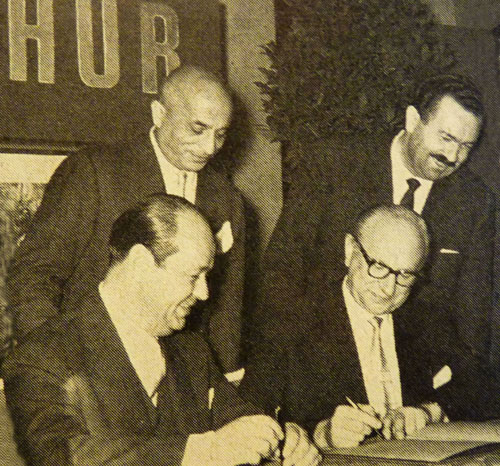 Festive Signing Convention. Sitting at the table: Erich Steinberg (l.),
MGM's General Director of Germany, and Rudolf Englberth (r.), owner of
Munich's Royal-Palast, signed on 27 October 1959 - that had already been
before the movie's world premiere in New York on 18 November - the first
European deal for the release of "Ben-Hur" in Munich. Behind them: Elias
Lapinère (l.), MGM's Chief Press Officer of Europe and Dr. Otto Schedl (r.),
Bavaria's Minister of State for Economy and Transport. (Image from
"Filmwoche") Festive Signing Convention. Sitting at the table: Erich Steinberg (l.),
MGM's General Director of Germany, and Rudolf Englberth (r.), owner of
Munich's Royal-Palast, signed on 27 October 1959 - that had already been
before the movie's world premiere in New York on 18 November - the first
European deal for the release of "Ben-Hur" in Munich. Behind them: Elias
Lapinère (l.), MGM's Chief Press Officer of Europe and Dr. Otto Schedl (r.),
Bavaria's Minister of State for Economy and Transport. (Image from
"Filmwoche")"Ben-Hur" was the focus of a reception hosted by the Bavarian Minister of State for Economy and Transport, Dr. Otto Schedl, on behalf of MGM in the foyer of the new Hercules Hall at the Munich Residence on 27 October 1959. In the presence of leading representatives from public life, the movie industry and the trade press, Rudolf Englberth, owner of the Munich Royal-Palast, and MGM Germany Director Erich Steinberg signed the first European cinema contract for "Ben-Hur". According to "Filmblätter", this contract probably contained the longest run and the largest amount of money that had ever figured in such an agreement. By way of thanks, Dr. Schedl received an antique Roman gold coin from Chief European MGM Press Officer Elias Lapinère as a small token of appreciation. More than 130 guests came to the festive meeting. |
|
First Advertising Campaigns for the Major Movie
|
|
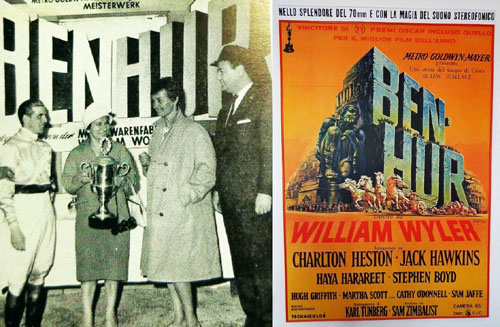 A cup for the proud winning couple (image from "Filmblätter")
and on the right: "Nello splendore del 70mm e con la magia del suono
stereofonico" (In the splendor of 70mm and with the magic of stereophonic
sound) - an impressive Italian movie poster. (Photo taken by the author) A cup for the proud winning couple (image from "Filmblätter")
and on the right: "Nello splendore del 70mm e con la magia del suono
stereofonico" (In the splendor of 70mm and with the magic of stereophonic
sound) - an impressive Italian movie poster. (Photo taken by the author)The Swiss actress Liselotte Pulver, assisted by Munich MGM Branch Manager K. Schreiber (both on the right), handed the winner's cup to the winning couple. This was an event that featured in many regional newspapers at the time. The local advertising campaign for "Ben-Hur" started back in May 1960. In order to give Munich citizens a taste of one of the film's great events, the Chariot Race, Metro-Goldwyn-Mayer put on a horse race in Munich-Riem (Galopprennbahn Riem) and offered a "Ben-Hur" cup as the prize. |
|
Suggestions sent by MGM to the Managers of the Premiere Cinemas in Germany
|
|
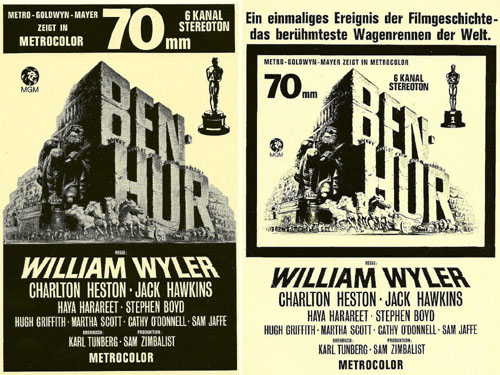 It is now up to you to take all appropriate measures to inform all the
residents in your area about the spectacular event, demonstrating your
genuine interest and using your frequently proven showman’s experience. That
is why we rely on your initiative and your extensive experience and wish you
and us every success with the advertising for BEN-HUR! It is now up to you to take all appropriate measures to inform all the
residents in your area about the spectacular event, demonstrating your
genuine interest and using your frequently proven showman’s experience. That
is why we rely on your initiative and your extensive experience and wish you
and us every success with the advertising for BEN-HUR!Advance advertising … right up to the starting date Please coordinate the use of slides and the trailer with your MGM branch as soon as possible. The trailer should run for at least 6 weeks prior to the premiere. Your foyer will need to be decorated with special grandeur to match the greatness and significance of the BEN-HUR movie. The first display cases, special panels, etc. should be produced in order to be ready for the first day the advertising trailer is shown. Make sure to plan the displays in your foyer in good time to enable you to gradually complement the initial decorations over the following few weeks until your entire foyer is dedicated exclusively to BEN-HUR on premiere day. Please do not forget to clearly indicate the advance booking option one week before the start. The Façade Before making any decisions on displaying faces, scenes from the chariot race, etc., please check the likely reaction of your public once again. Without exaggeration, BEN-HUR is enjoying the most lavish advance advertising in movie history. Millions of people are waiting for this movie and its highlights. It might be best if you limit the decoration on the façade of your establishment to a gigantic title accompanied by a four-horse chariot. If you want to put a slogan up on your façade, we recommend: NEW – on the big screen – the greatest work in movie history – awarded 11 Oscars – in 70mm! |
|
First Release in Germany
|
|
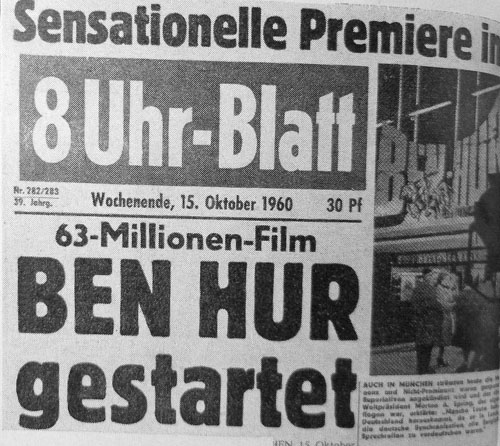 A Munich newspaper: The 63 Million D-Mark Film "Ben-Hur" has sensationally
premiered. A Munich newspaper: The 63 Million D-Mark Film "Ben-Hur" has sensationally
premiered.The first German reviews about the movie, published in the "Berliner Filmblätter" amongst others, included the following descriptions: "Based on the story around the literary character of Prince Judah Ben-Hur, the director created an astonishing mixture of high tension, grandiose drama, exalted emotion, wild adventure and epic storytelling. The camera wallows in a quite fantastic opulence of colour and props. It celebrates turbulent triumphs during the already famous chariot race. The close shots of the fast-paced action force the public to become immersed in the explosive confrontation between the two rivals. That is the grandiose highlight of this the most colossal of all colossal movies! Heston as the protagonist is a reliable eponymous hero. He is surrounded by various strongly drawn characters: Hawkins (Quintus Arrius) a manly sympathetic commander of the fleet, Boyd (Messala) a cold-hearted tribune, Griffith (Sheik Ilderim) a shrewd Arab sheik and a pleasantly light-handed caricature of Roman Emperor Tiberius, played by George Relph. Architecture and music are monumentally massive. For nearly 4 hours (with one interval), the audience is fascinated, overwhelmed and stunned - but also has to sit patiently through a few rather drawn-out sections." (Do) Rudolf Englberth, the owner (entrepreneur) of Munich's Royal-Palast, hired for the film's premiere students and dressed them up in Roman costumes to enhance the event's atmosphere. MGM's International President, Morton A. Spring, came across from the US just for the premiere. MGM organised joint advertising campaigns with displays in the windows of 63 shops of various kinds in Munich and ensured that the premiere on 14 October was promoted effectively. |
|
Premiere in Hamburg, 15 December 1960 at the Savoy-Filmtheater |
|
 On the left: Premiere opening announcement advert dated 28 November 1960 and
on the right: The last week at this cinema. (Advert dated 14 March 1963) On the left: Premiere opening announcement advert dated 28 November 1960 and
on the right: The last week at this cinema. (Advert dated 14 March 1963) After its premiere, which took place on 15.12.1960, the movie ran for a solid 118 weeks at the Hamburg Savoy-Filmtheater. That is a run that is unheard of in these, partly unfortunately, very fast-moving times. The "Hamburger Abendblatt" newspaper reported on 13.11.1962: "By Wednesday, the movie "Ben-Hur" had run for 100 weeks. That is an absolute record for Hamburg. The movie still has the same attraction as in week 40 - some 150 visitors per day and up to 450 per screening at weekends. The total figure stands at over half a million." A few small anecdotes: and as for the cinema employees? They were out of their minds. Some people actually handed in their notice. The reason: "We can't stand this movie any more. It is making us ill." The cinema manager reported to the "Hamburger Abendblatt" newspaper that what he liked best was to occasionally control the sound level in the cinema himself. During the chariot race and the sea battle he could then really turn up the volume - particularly when the time came for the thunderstorms at the end of the movie. It nearly knocked the audience off their seats. "Ben-Hur" also had its repeat viewers. One young man, a bank clerk, had already seen the movie 253 times. He sat in seat 17 in the second row every single time. His brief verdict about the movie: "Brilliant!" |
|
Premiere in Berlin, 20 January 1961 at the Delphi-Filmpalast am Zoo |
|
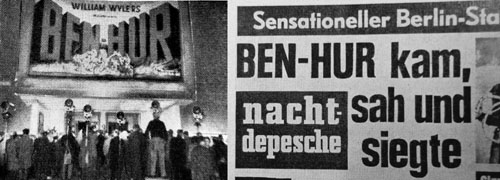 On the left: Spotlight on! Festive premiere of the movie at the
Delphi-Filmpalast am Zoo (image from "Filmblätter") and on the right:
Sensational Premiere: BEN-HUR came, saw and conquered. (A Berlin newspaper) On the left: Spotlight on! Festive premiere of the movie at the
Delphi-Filmpalast am Zoo (image from "Filmblätter") and on the right:
Sensational Premiere: BEN-HUR came, saw and conquered. (A Berlin newspaper)The premiere was also the talk of the town in Berlin. One of the most popular red-tops of the day, "Nacht-Depesche", even published a Ben-Hur special edition. The event had been widely announced at many places within the city for a long time in shop windows and on billboards. 31 huge shop windows of the department stores "KaDeWe" (Kaufhaus des Westens / Department Store of the West) and "Karstadt at Hermannplatz" alone were dressed with references to "Ben-Hur". At the premiere, "legionnaires" in historic costumes guarded the entrance to the venue. Berlin VIPs milled around the foyer - including movie producer Artur Brauner, Gisela Uhlen, Carla Hagen and Michiko de Kowa-Tanaka. (Source: "Filmblätter") The movie is to be shown in the following procedure (MGM's instructions to the theatre manager): A.) Overture 6:32 minutes B.) Prologue (The Nativity) 7 minutes (latecomers should not be permitted to take a seat. When the film's title is projected onto the screen, latecomers may be seated quietly) C.) First Part of the Movie 2 hours and 7 minutes D.) Intermission 15 minutes (the Intermission should not exceed a total of fifteen minutes or be less than ten. After 11 minutes of Intermission signal booth to start soundtrack music (Entr'acte, 3:47 minutes) and signal patrons to return to their seats by gong, chimes or bell and the flashing of the lobby and lounge lights to return to their seats). E.) Second Part of the Movie 1 hour and 15 minutes F.) End - no exit music is to be played |
|
A successful run throughout Germany |
|
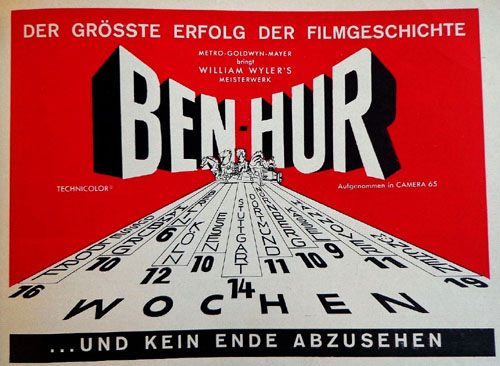 To date, on 03 March 1961, the movie had already been successfully shown in
various German cities for many weeks and the show went on…: To date, on 03 March 1961, the movie had already been successfully shown in
various German cities for many weeks and the show went on…:Düsseldorf 16 weeks Dortmund 11 weeks Hamburg 10 weeks Nürnberg 10 weeks Berlin 6 weeks Kassel 9 weeks Köln 12 weeks Hannover 11 weeks Essen 10 weeks München 19 weeks Stuttgart 14 weeks According to statistics from the "Berliner Filmblätter", 17 million visitors worldwide had seen the movie in 286 cinemas at 35.345 screenings by the end of 1960. During the last 10 days of that year alone, from 22.12.1960 to 31.12.1960, the movie brought in revenues of some 3.3 million dollars. 2.2 million dollars in the USA and Canada and 1.1 million dollars in the remaining countries. The American artist Reynold Brown (18.10.1917 - 24.08.1991) drew the film's well-known posters. Amongst others, he also designed movie poster motifs of other great movies such as: "Spartacus" (USA, 1960), "The Alamo" (USA, 1960), "King of Kings" (USA, 1961), "The Wonderful World of the Brothers Grimm" (USA, 1962) and "How the West Was Won" (USA, 1962). |
|
Advertising for the movie in Austria |
|
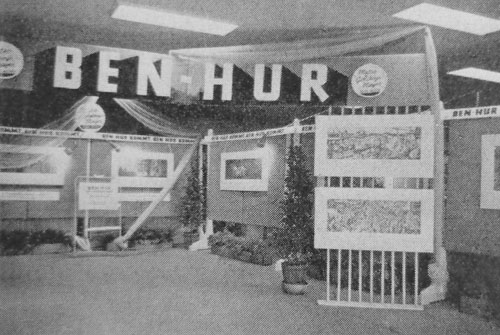 A "Ben-Hur"-
Exhibition in a Department Store in Vienna.
A view of the exhibition. (Image from the "Österreichische Film- und
Kinozeitung") A "Ben-Hur"-
Exhibition in a Department Store in Vienna.
A view of the exhibition. (Image from the "Österreichische Film- und
Kinozeitung")In the spring of 1960, an exhibition entitled "Szenengraphik aus Ben-Hur" (conceptual drawings for Ben-Hur) was put on in the basement of the Vienna Neumann department store (now the "Steffl" department store - one of the classiest department stores in Vienna), in Kärntnerstraße 19. The exhibits included various drawings by the famous American artist Benjamin A. Stahl (07.09.1910 - 19.10.1987) or "Ben Stahl" for short. His drawings were subsequently also used to make individual scenery for the major movie. Entrance to the exhibition was free to the public. (Source: "Österreichische Film- und Kinozeitung" dated April 1960) The original English hardcover souvenir book for "Ben-Hur", which was available in the cinemas at the time (publisher: Random House), contains 6 fold-out drawings by the artist at the back. In Vienna, the movie premiered on 14 September 1961 in the Tabor cinema (1916 -1996), which was located in the 2nd District of Vienna (Leopoldstadt). Previously, the cinema was closed on 26 May 1961 for extensive refurbishment and reopened with great ceremony on 14 September 1961 as Austria's most modern cinema with "Ben-Hur". After the refurbishment, only 774 (more comfortable) of the original 1048 seats remained. The old 18 x 6.5 metres (59,1 x 21,3 feet) screen was replaced by an even bigger "MGM Camera 65"- screen measuring 19 x 7.1 metres (62,3 x 23,3 feet). (Source: "Österreichische Film- und Kinozeitung" dated September 1961) On 14 / 15 September 1962, the Tabor celebrated one year of screenings of the movie. Some 275.000 visitors had enjoyed the cinematographic work in the cinema that year. The figure for the other Austrian federal states was approximately 390.000 - making it a total of some 665.000 visitors throughout Austria. (Source: "Österreichische Film- und Kinozeitung") |
|
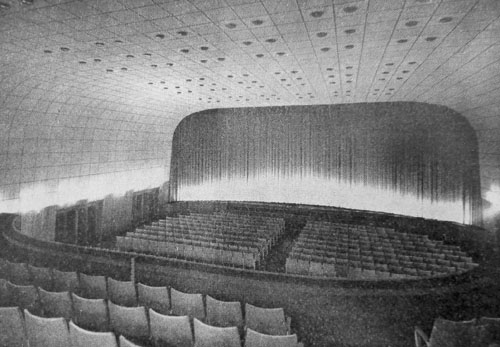 Vienna’s reopened and refurbished Tabor cinema. (Image from the
"Österreichische Film- und Kinozeitung" dated September 1961) Vienna’s reopened and refurbished Tabor cinema. (Image from the
"Österreichische Film- und Kinozeitung" dated September 1961)"Ben-Hur" ran at the Tabor until the beginning of March 1963, followed by Walter Lang's (10.08.1896 - 07.02.1972) musical "Can-Can" (USA, 1960), presented in Todd-AO 70mm. Previously, Lang had directed the famous movie "The King and I" (USA, 1956) - shot in CinemaScope 55. This was a new filming process developed by 20th Century Fox in the middle of the 1950s. Here, the negative film was 55.6mm wide and each individual frame 8 perforations tall. It had been shot with anamorphic lenses. So, this is somehow a thing between CinemaScope and Todd-AO. The first big movie which had been shot in this process is "Carousel" (USA, 1956). Afterwards "The King and I" came into the cinemas and then it was already over with CinemaScope 55. Although the movies were shot and promoted in the new wide-screen process, the version for commercial distribution to the cinemas was a 35mm CinemaScope reduction print with 4-channel magnetic sound, which did, however, make for good picture quality thanks to the reduction. To do justice to the increasingly number of cinemas which had installed 70mm projectors in their projection rooms Fox introduced with the movie "The King and I", premiered on 23 March 1961 at the Rivoli Theatre in New York, its new short-lived 70mm wide-screen process called "Grandeur 70". At that time, the 70mm print was produced from a CinemaScope 55 negative film (55,6mm) through optical enlargement and decompression "without anamorphic squeeze". It was equipped with 6-channel magnetic sound. The process subsequently faded away as no more movies were shot in the CinemaScope 55 process. |
|
The venerable, Oscar-awarded Score
|
|
 "Ben-Hur" Original Soundtrack LP. Deluxe Box Edition (here: 1E1-mono) which
includes a German and an English (hardcover) souvenir brochure of the film.
(From the author´s collection) "Ben-Hur" Original Soundtrack LP. Deluxe Box Edition (here: 1E1-mono) which
includes a German and an English (hardcover) souvenir brochure of the film.
(From the author´s collection)"The musical score by Miklos Rozsa, whose qualifications for this task are unsurpassed, is moving and beautiful", said Joseph R. Vogel, President of MGM. The music on this LP was conducted by Carlo Savina, played by the Symphony Orchestra of Rome, also with the singers of the Roman Basilicas. Dr. Rozsa supervised the recording in Rome for MGM records in 1959. Contractual restrictions prevented him from conducting personally. A short article published during the time of the film's road-show premiere in the "New York VARIETY" reads as follows: MGM's In-a-"Hur"-ry Disks MGM Records was working in three diversified areas to get its "Ben-Hur" package into the stores in time for the movie's premiere in New York last week. The disk was made in England, the boxed package was produced by the Imperial Paper Co. in Brooklyn (New York) and the 36-page Souvenir Book (Author's comment: The hardcover edition includes additional fold-out artwork) was printed in Hammond (Indiana). Everything was brought together only five days before the movie's opening and collated for retail delivery. Diskery has also taken care of other distributors - so they can time their push to the movie's openings, for example, in Los Angeles, Philadelphia and Boston. MGM has also set up a hefty promotion campaign for the package with such display material as color posters showing scenes from the movie, background wallpapers, blow-ups of the album cover, window streamers, special mailing pieces, etc. A film playdate service listing has been circulated along with a matching list of names and addresses of MGM's film branch managers and exploitation men. The MGM deluxe package, featuring the music of Miklos Rozsa, retails at $4.98 (monaural) and $5.98 (stereo). Company is also issuing a low-price Lion LP of musical highlights from the movie. MGM's "Ben Hur", "sweeping" all before it in the 32nd Annual Academy Awards, now receives breath-taking confirmation from the entire motion picture industry to the fabulous esteem in which it is held by the public-at-large. Included among its glittering array of Oscars are those of both "Best Film of the Year" and "Best Music Score for a Dramatic Film". MGM RECORDS is proud to present the original music from this incomparable motion picture. In the 1960s, MGM RECORDS produced some of the stunning Deluxe Box Editions with the scores of their big movies. Each included a long playing record and the souvenir film brochure of the film - here in Germany in addition, the German version of the brochure. In Germany following boxes were available (Mono/Stereo): A.) "Ben-Hur" (USA, 1959) - Music by Miklos Rozsa (1E1/S1E1) B.) "King of Kings" (USA, 1961) - Music by Miklos Rozsa (1E2/S1E2) C.) "How the West Was Won" (USA, 1962) - Music by Alfred Newman (M 009 010 / ST 109 010) D.) "Mutiny on the Bounty" (USA, 1962) - Music by Bronislau Kaper (1E4/S1E4) (The records were manufactured by the Deutsche Grammophon Gesellschaft) In America additionally: E.) "The Wonderful World of the Brothers Grimm" (USA, 1962) - Music by Leigh Harline / Bob Merrill (with dialogues) (1E3/S1E3) At the time, Colpix Records also released a Deluxe Box Edition (LE1000, Limited Edition) of the movie "Lawrence of Arabia" (UK, 1962) - of course, with included souvenir brochure. (See image at the end of the report) |
|
A re-run in Hamburg |
|
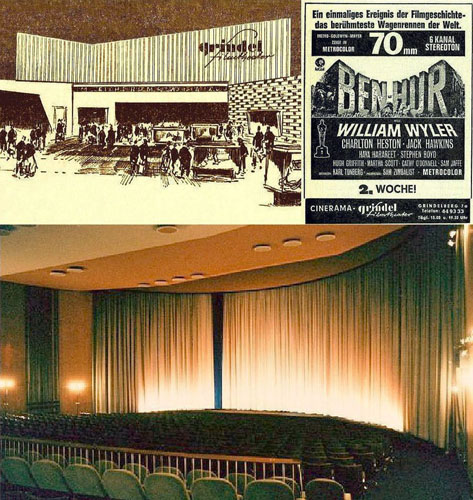 "Ben-Hur" projected onto the huge, deeply curved Cinerama screen in my
beloved Hamburg Grindel-Filmtheater. A re-run from 30 January to 26 March
1970. (Images from the author`s collection) "Ben-Hur" projected onto the huge, deeply curved Cinerama screen in my
beloved Hamburg Grindel-Filmtheater. A re-run from 30 January to 26 March
1970. (Images from the author`s collection) In January 1963, The Grindel Filmtheater had been equipped with a louvered Cinerama screen (27 by 10 meters - measured along the curve) which was ceremonially inaugurated on 01 February 1963 with the German Gala Premiere of the Cinerama movie "How the West Was Won" (USA, 1962). It is told that among the premiere guests were Hardy Krüger and Willy Fritsch. The cinema was demolished in April 2009. The anamorphic 70mm version of "Ben-Hur" was projected horizontally expanded with a special projection lens in an aspect ratio of 2.76:1 onto the large cinema screens. This lens had been developed by Panavision, Inc. and was ready for use when "Ben-Hur" premiered in November 1959 in New York. |
|
Final Words |
|
 The chariot race and the sea fight. I drew the pictures in 1967. Sheer
enthusiasm about the movie inspired me at the time. The chariot race and the sea fight. I drew the pictures in 1967. Sheer
enthusiasm about the movie inspired me at the time.Already Fred Niblo's silent version of "Ben-Hur" (USA, 1925) had been with cost of more than 4 million dollars the costliest film made up to its time. It took 3 years of production and became Metro-Goldwyn-Mayer's first great 'public-relations-success´. William Wyler's excellent remake of "Ben-Hur" (USA, 1959) is Hollywood at its-very-best! The movie is full of drama, action and romance - almost all human sentiments are represented in the story. Here another thought of mine. Less is sometimes better and perhaps also more realistic. Miriam and Tirzah, Judah Ben-Hur's mother and sister, are healed of their leprosy disease during the storm at the end of the film. I am having difficulty with that. It would be nice if there were such miracles. |
|
 Soundtrack Deluxe Box Editions (LPs) and souvenir film brochures. (From the
author's collection) Soundtrack Deluxe Box Editions (LPs) and souvenir film brochures. (From the
author's collection)I saw "Ben-Hur" for the first time start of the 1960s. The huge impression the epic movie made on me then is still lingering. I was enthralled by the moving story, the believable actors, the superb dialogues, the impressive costumes, the good camera work, the particularly wide image projected onto the huge screen >size matters< combined with the all-enveloping 6-channel magnetic sound, etc. Of course, I was also very taken with the orchestral film music by Dr. Rozsa. I think that it added to the movie's greatness. Thankfully, William Wyler's "Ben-Hur" became a box office triumph that saved MGM from impending ruin at the time. After the "Ben-Hur" - shootings in Rome it is told that, when Charlton Heston got ready travelling back to America, William Wyler came over and said with a smile: "Thanks, Chuck, for everything. I just hope I can give you a better part next time!". Heston remarked at the time: "Doing a film for Wyler is like getting the works in a Turkish bath. You damn near drown but you come out smelling like a rose." In memory of Sam Zimbalist, the movie's producer, who passed away while filming on 04 November 1958. He saw in "Ben-Hur" the crowning of his life's work. |
|
Sources |
|
|
The report was compiled using various articles as well as pictorial
material, which were in part taken from newspapers and journals of the time,
in particular: "Filmblätter", "Filmwoche", "Film-Echo", "Der Neue Film", "La
Cinématographie Francaise", "Österreichische Film- und Kinozeitung", "New
York VARIETY", "Motion Picture Herald" and from the author's collection. Charlton Heston : "In the Arena", Simon & Schuster, ISBN 0-684-80394-1, 1995 |
|
| Go: back - top - back issues - news index Updated 22-01-25 |
